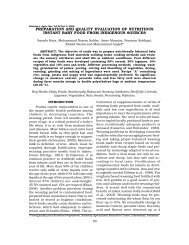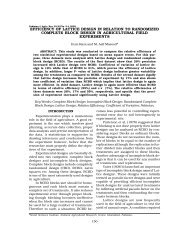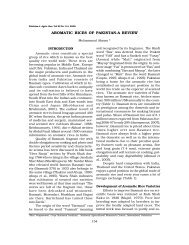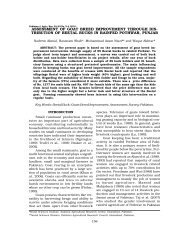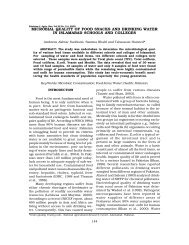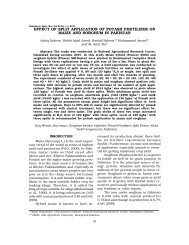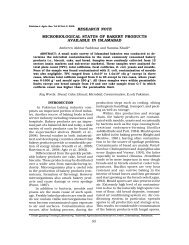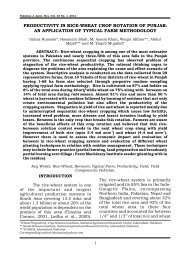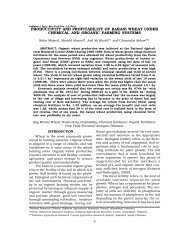promoting certified seed availability of wheat (triticum ... - PJAR
promoting certified seed availability of wheat (triticum ... - PJAR
promoting certified seed availability of wheat (triticum ... - PJAR
Create successful ePaper yourself
Turn your PDF publications into a flip-book with our unique Google optimized e-Paper software.
Pakistan J. Agric. Res. Vol. 25 No. 3, 2012PROMOTING CERTIFIED SEED AVAILABILITY OF WHEAT (TRITICUMAESTIVUM L) THROUGH PUBLIC-PRIVATE PARTNERSHIP AND ITSIMPACT ON YIELD IN RAINFED AREASMuhammad Tariq*, Raja Muhammad Omer**, Muhammad Ashraf Mian*,Obaid Ur Rehman***, Amjad Tahir Virk and Kazim Abbass**ABSTRACT:- The use <strong>of</strong> poor quality <strong>seed</strong> results in poor crop stand andeventually in lesser vegetative growth leading to poor crop yield. Hence, itis the need <strong>of</strong> the time to enhance provision <strong>of</strong> <strong>certified</strong> <strong>seed</strong> <strong>of</strong> improvedvarieties to the farmers. An approved <strong>wheat</strong> variety 'Chakwal-50' <strong>of</strong> rainfedareas was selected for <strong>certified</strong> <strong>seed</strong> production and distribution in rainfedDistrict Chakwal under joint venture <strong>of</strong> a study on comparison <strong>of</strong> <strong>seed</strong>source(Certified vs. Farmer's <strong>seed</strong>) contribution towards <strong>wheat</strong> yield at sixsites in the District. All the agronomic practices were the same in both-2treatments. The number <strong>of</strong> fertile tillers m were significantly higher in<strong>certified</strong> <strong>seed</strong> source than the farmer's own <strong>seed</strong> that resulted in significantincrease in grain yield. Other yield contributing parameters includingnumber <strong>of</strong> spikelet per spike, numbers <strong>of</strong> grains per spike and 1000 grainweight were at par in both <strong>seed</strong> sources. It was concluded that healthy andpure <strong>seed</strong> source gave high <strong>seed</strong> germination and good crop stand whichenabled the plants to withstand abiotic stress especially drought during thecrop season. The <strong>seed</strong> multiplication <strong>of</strong> crop varieties <strong>of</strong> rainfed areas canbe done in irrigated areas to ensure the quality <strong>of</strong> <strong>seed</strong> and its <strong>availability</strong> inrainfed areas, which ultimately will increase the income <strong>of</strong> the farmingcommunity <strong>of</strong> the area.Key Words: Wheat; Certified Seed; Rainfed Farming; Public- PrivatePartnership; Crop Yield; Income; Pakistan.INTRODUCTIONWheat crop yield is very low inrainfed areas due to the use <strong>of</strong> oldand obsolete varieties by most <strong>of</strong> thefarmers. Consequently area under<strong>wheat</strong> crop is reducing, resulting indecreased production and eventuallyfarmers loose pr<strong>of</strong>it, which increasespoverty level within the localcommunity. Another consequence <strong>of</strong>the prevailing situation is the changein land use from agriculture tocommercial purposes. The process <strong>of</strong>land use conversion could beretarded if productivity from availableland could be enhanced. An essentialelement for increasing productivity<strong>of</strong> any crop is provision <strong>of</strong> quality<strong>seed</strong>. The <strong>certified</strong> <strong>seed</strong> <strong>of</strong> recommendedvarieties is available tovery few farmers in Pakistan. Thesituation is even worse in rainfedareas as authentic <strong>seed</strong> companiesincluding Punjab Seed Corporation(PSC) are not supplying <strong>certified</strong> <strong>seed</strong><strong>of</strong> even main cash crops in the area(GoP, 2010). The frequent climaticvariations in the areas discouragethe <strong>seed</strong> companies to manufacture*Barani Agricultural Research Institute , Chakwal, Pakistan.**Sustainable Land Management Project, Lahore, Pakistan.***Zamindara Seed Corporation, Okara, Pakistan.Corresponding author:barichakwal@yahoo.com174
MUHAMMAD TARIQ ET AL.and market quality <strong>seed</strong> to farmersin the rainfed areas. The farmers areconsequently using poor quality oldlow yielding varieties <strong>seed</strong> producedlocally. Due to non-<strong>availability</strong> <strong>of</strong> improved<strong>seed</strong> in rainfed tract substantialarea remains devoid <strong>of</strong> agriculturecrops that result in exposure<strong>of</strong> soil to erosion and leads to soil degradationand desertification.It was, therefore, essentially requiredto explore mechanism for<strong>availability</strong> <strong>of</strong> <strong>certified</strong> <strong>seed</strong> <strong>of</strong> improvedvarieties to farmers in therainfed areas to prevent further expansion<strong>of</strong> land degradation and desertificationprocess. Furthermore, acomparison between the farmer'sown <strong>seed</strong> and <strong>certified</strong> <strong>seed</strong> had to bemeasured to ascertain magnitude <strong>of</strong>effect on crop yield. Besides that, theimpact <strong>of</strong> supply <strong>of</strong> supplementaryirrigation water on yield <strong>of</strong> <strong>certified</strong><strong>seed</strong> in rainfed areas had to begauged to realize the maximum potential<strong>of</strong> the improved variety insemi- arid environment.MATERIALS AND METHODThe study was conducted in therainfed District <strong>of</strong> Chakwal andirrigated District <strong>of</strong> Okara in Punjabprovince during 2010-12. The firstpart <strong>of</strong> the study is the Public PrivatePartnership (PPP) mode for <strong>certified</strong><strong>seed</strong> production in District Okaraand the second part is the distribution<strong>of</strong> <strong>certified</strong> <strong>seed</strong> in DistrictChakwal and assessment <strong>of</strong> the cropyield.Public-Private Partnership inSeed ProductionAn innovative approach wasadopted to overcome the climaticvariations that affect production <strong>of</strong><strong>certified</strong> <strong>seed</strong> in the rainfed areas. APPP arrangement was concludedbetween Zamindara Seed Corporation(ZSC) and the Government <strong>of</strong>Punjab through the funds providedby the Sustainable Land ManagementProject (SLMP). The standardoperating procedures (SOPs) approvedby the Government <strong>of</strong> Punjabfor functioning <strong>of</strong> Foundation SeedCell established in the Ayub AgricultureResearch Institute, Faisalabadwere used. The project invitedsealed bids from the 25 <strong>seed</strong>companies to produce <strong>certified</strong> <strong>seed</strong>with the support <strong>of</strong> SLMP and BaraniAgricultural Research Institute(BARI), Chakwal. ZSC gave thehighest bid to contribute 52% <strong>of</strong> thetotal cost <strong>of</strong> the project.The production <strong>of</strong> <strong>certified</strong> <strong>seed</strong>was restricted to <strong>wheat</strong> since it wasthe main cash crop in the study area.Chakwal-50, a high yielding droughttolerant variety developed by BARIwas selected for <strong>seed</strong> production.Basic <strong>seed</strong> <strong>of</strong> Chakwal-50 wasprovided by BARI to the ZSC for theproduction <strong>of</strong> <strong>certified</strong> <strong>seed</strong> throughcontract growers in Okara District.The Geographic Information System(GIS) specialist <strong>of</strong> SLMP measuredthe area cultivated using GlobalPositioning System (GPS) and RemoteSensing (RS) techniques. The<strong>seed</strong> crop was monitored by BARIand Federal Seed Certification andRegistration Department, Islamabad(FSC& RD ) for true to type, purityand healthy <strong>seed</strong> production.The ZSC procured <strong>seed</strong> <strong>of</strong> thevariety from the contract growers onpremium price. The process <strong>of</strong> <strong>seed</strong>grading/cleaning/storage/fumigation and packing under requiredconditions was carried out by ZSCunder the supervision <strong>of</strong> BARI and175
PROMOTING CERTIFIED SEED AVAILABILITY OF WHEATFSC&RD. The <strong>certified</strong> <strong>seed</strong> producedby the ZSC in District Okarawas made available to farmers inDistrict Chakwal through four <strong>seed</strong>dealers, BARI and also from itsheadquarter in District Okara.Comparison <strong>of</strong> Crop YieldThe <strong>certified</strong> <strong>wheat</strong> <strong>seed</strong> (T 1) andfarmer's own kept <strong>seed</strong> (T ) were2sown at six different sites to comparethe yield from the two treatmentsunder rainfed conditions in Chakwaldistrict. One acre plot size, 45 kg-1acre <strong>seed</strong> rate and 22.5 cm row spacingwas maintained for bothtreatment. Similar cultural practicesand fertilizer doses (one bag each <strong>of</strong>Diammonium phosphate, urea andpotash per acre) were applied on allplots at the time <strong>of</strong> sowing. Thetreatments were sown on November21, 2011 and harvested on April, 28-30, 2012. Different variables onplant growth measured during thetrial included plant height (cm),-2number <strong>of</strong> fertile tillers m , spikelength (cm), numbers <strong>of</strong> spikelets-1 -1spike , number <strong>of</strong> grains spike ,1000 grain weight (g) and grain yield-1(tha ). The results <strong>of</strong> different cropvariables were bulked up to eachlocation and treatment for the principalcomponent analysis (PCA) (Jolliffe,1986). The ANOVA means forcrop yield <strong>of</strong> <strong>certified</strong> and farmer's<strong>seed</strong> for different sites were obtainedby using MSTAT-C statistical analysesprogramme (Steel and Torrie,1980). The ANOVA means for cropyield <strong>of</strong> <strong>certified</strong> <strong>seed</strong> under irrigatedand rainfed conditions was obtainedby using MSTAT-C statistical analysesprogramme. The overall differencesbetween individual meanswere examined by LSD tests(Cochran and Cox, 1957). Any twomeans whose difference exceededthe LSD value at alpha=0.05 wereconsidered to be significantly different.RESULTS AND DISCUSSIONPublic-Private Partnership in SeedProductionDue to timely <strong>availability</strong> <strong>of</strong> canalirrigation water in District Okaraduring rabi season the <strong>seed</strong> crop <strong>of</strong><strong>wheat</strong> was satisfactory as <strong>certified</strong> inthe reports <strong>of</strong> FSC&RD. ZSC had toplant the basic <strong>seed</strong> (3750 kg) <strong>of</strong> thevariety over 75 acres as peragreement to produce <strong>certified</strong> <strong>seed</strong>in District Okara, however, usingabout 136,639 kg <strong>seed</strong> was procuredfrom the growers by the ZSC and90,000 kg quality <strong>seed</strong> waseventually obtained after cleaning/gradingetc. It can be estimatedthat about 34% <strong>seed</strong> was lost duringthe grading, cleaning and packagingstages. The major distribution <strong>of</strong><strong>certified</strong> <strong>seed</strong> in District Chakwalwas through BARI (25,300 kg)whereas the remaining distribution<strong>of</strong> <strong>seed</strong> was through four <strong>seed</strong>dealers <strong>of</strong> Tehsil Talagang and KalarKahar.Comparison <strong>of</strong> Crop YieldThe results showed that theaverage <strong>of</strong> 6 locations for two parametersi.e., number <strong>of</strong> fertile tillers-2m and number <strong>of</strong> spikelet per spikewere significantly different for farmer'sown <strong>seed</strong> and <strong>certified</strong> <strong>seed</strong>.Whereas, there was no significantdifference between the farmers's own<strong>seed</strong> and <strong>certified</strong> <strong>seed</strong> among plantheight, spike length, number <strong>of</strong>grains per spike and 1000 grainweight. Meaningfully, the percent-2increase in number <strong>of</strong> tillers m and176
MUHAMMAD TARIQ ET AL.Table 1.Location wise comparisonn <strong>of</strong> <strong>certified</strong> and farmer's own <strong>seed</strong> for yieldand yield components under rainfed conditions <strong>of</strong> <strong>wheat</strong> in ChakwalDistrictLocation Seed source Height(cm)No. <strong>of</strong> fertiletillers(m 2 )Spikelength(cm)No. <strong>of</strong>spike lets/spikeNo. <strong>of</strong>grains/ spike1000 grainwt (g)Yield(tha -1 )JhamraCertified <strong>seed</strong> 89.0 400.0 9.8 18.3 20.3 26.7 2.18Farmer’s own <strong>seed</strong> 85.3 278.3 7.7 14.3 18.3 37.5 1.79MianiCertified <strong>seed</strong> 82.7 409.3 10.1 19.0 25.0 33.5 3.48Farmer’s own <strong>seed</strong> 84.3 309.3 9.3 17.0 26.3 41.7 3.01DhurnalCertified <strong>seed</strong> 78.7 246.3 9.7 18.3 19.7 24.6 1.00Farmer’s own <strong>seed</strong> 86.0 201.3 8.7 13.0 18.7 24.3 0.76Pindi GujranCertified <strong>seed</strong> 82.7 361.0 9.7 19.0 24.0 33.9 2.50Farmer’s own <strong>seed</strong> 83.3 268.3 8.7 16.3 25.0 28.2 1.70TalagangCertified <strong>seed</strong> 84.3 351.7 10.5 19.0 29.7 33.5 3.13Farmer’s own <strong>seed</strong> 85.0 256.3 10.0 18.3 24.7 28.9 1.84Rahna SadaatCertified <strong>seed</strong> 91.3 322.0 10.7 18.3 29.7 28.5 2.47Farmer’s own <strong>seed</strong> 76.7 192.3 9.6 19.0 24.0 26.1 1.00Avg. <strong>of</strong> 6locationsCertified <strong>seed</strong> 84.8 348.4 10.1 18.7 24.7 30.1 2.46Farmer’s own <strong>seed</strong> 83.4 251.0 9.0 16.3 22.8 31.1 1.66% increase overfarmer’s own <strong>seed</strong>2 28 11 13 8 -3 32number <strong>of</strong> spikelet per spike was28% and 13% for <strong>certified</strong> <strong>seed</strong> overfarmer's own <strong>seed</strong>, respectively(Table 1).The PCA indicated that the cropyield obtained from the farmer's <strong>seed</strong>was strongly correlated to thenumber <strong>of</strong> tillers and 1000-grainweight (Table 2). Furthermore, theincrease in number <strong>of</strong> tillers wascorrelated with 1000-grain weight(Table 2). It can be inferred that theyield from farmer's own <strong>seed</strong> was dependentupon the number <strong>of</strong> tillerswhereas the length <strong>of</strong> spikes impactedthe yield <strong>of</strong> <strong>certified</strong> <strong>seed</strong>. Thegermination <strong>of</strong> non-<strong>certified</strong> <strong>seed</strong> isrelatively low that increases spacebetween the plants. Consequentlythe number <strong>of</strong> tillers was relativelymore in non-<strong>certified</strong> <strong>seed</strong> to fill upthe empty space between plantsTable 2.Variables Yield Height No. <strong>of</strong>TillersFarmer SeedYield 1Height 0.287 1No. <strong>of</strong> tillers 0.931 0.485 1Cross-products matrix containingcorrelation coefficientsamong crop variablesobtained through PrincipalComponents Analysis (PCA)for farmer and <strong>certified</strong> <strong>seed</strong>used at the six locationsSpikelengthSpike length 0.085 -0.406 -0.205 1Spikeletsspike -1Spikelets spike -1 0.246 -0.671 0.008 0.799 1Grains.spike -1 0.554 -0.360 0.340 0.729 0.805 1Grains 1000-spike -1 grain wt1000 grain wt. 0.890 0.390 0.897 -0.302 -0.079 0.143 1Certified <strong>seed</strong>Yield 1Height 0.265 1No. <strong>of</strong> Tillers 0.777 0.372 1Spike length 0.532 0.582 0.079 1Spikelets spike -1 0.735 -0.368 0.472 0.071 1Grains spike -1 0.657 0.433 0.142 0.924 0.378 11000 grain wt. 0.740 -0.121 0.642 0.021 0.747 0.238 1Degrees <strong>of</strong> freedom (df) = 28; Values in bold are significantlycorrelated at alpha = 0.05 for farmers’ <strong>seed</strong> and 0.01 forCertified <strong>seed</strong>177
PROMOTING CERTIFIED SEED AVAILABILITY OF WHEAT(Ahmad et al., 1999; Amjad andAnderson, 2006; Behera, 1995). Onthe contrary, the increase in length <strong>of</strong>spikes had strong correlation withthe grains produced per spike for<strong>certified</strong> <strong>seed</strong>. Due to better germination<strong>of</strong> <strong>certified</strong> <strong>seed</strong> the plantsare close to each other that allowvertical rather than horizontalgrowth. Presumably it was due to thesame reason that the length <strong>of</strong> spikeswas longer and eventually producedhigher number <strong>of</strong> grains per spikethat resulted in better yield <strong>of</strong><strong>certified</strong> <strong>seed</strong> (Lesznyak, 1996; Iqbalet al., 2010).The crop yield obtained from the<strong>certified</strong> <strong>seed</strong> was significantlyhigher than the <strong>seed</strong> used by thefarmers from own source (Table 3). A32% increase in crop yield was observeddue to use <strong>of</strong> <strong>certified</strong> <strong>seed</strong>.The difference in crop yield washighly significant between the sixsites for both <strong>certified</strong> and farmer's<strong>seed</strong> (Table 3). The overall interactionbetween the sites and <strong>certified</strong> <strong>seed</strong>was also highly significant. It is atypical feature <strong>of</strong> the rainfed areasthat the crop yield varies for differentsites and even within the same sitedue to climatic variation (Ercoli andMasoni, 1995; Malik et al., 1996).Availability <strong>of</strong> soil moisture onsustained basis particularly in semi-Table 3.Sites (ST)SeedQuality (S)Farmer <strong>seed</strong>(N=18)Certified <strong>seed</strong>(N=18)Mean (ST)N=36F test P-Value (S)ANOVA means <strong>of</strong> <strong>wheat</strong> yield-1(tha ) for farmer own <strong>seed</strong>and <strong>certified</strong> <strong>seed</strong> at differentsitesJamra Miani Talagang Pindi Bilal Rahna Mean (S) F test P-Gujran Abad SadatValue (ST)N=6 N=6 N=6 N=6 N=6 N=6 N=361.79 cd 3.00 a 0.75 e 1.69 d 1.83 cd 0.99 e 2.46 a2.17 bc 3.47 a 0.99 e 2.50 b 3.13 a 2.47 b 1.68 b1.98 c 3.24 a 0.88 d 2.10 bc 2.49 b 1.74 c0.00000.0075S*ST=0.0038LSD value = 5.306; LSD value for ST= 5.129 and for S=5.306 at alpha 0.05arid climatic conditions is a majorlimiting factor towards obtainingoptimum crop yield (Shoukat et al.,1999; Subhani et al., 2012).The yield obtained from the<strong>certified</strong> <strong>seed</strong> with application <strong>of</strong>tube well supplementary irrigationwas significantly higher than thatunder rainfed condition at two sites(Jhamra, Miani) in Chakwal (Table4). The increase in crop yield onovercoming the water limitation was41%. This has clearly been shownfrom the results that even the yield <strong>of</strong><strong>certified</strong> <strong>seed</strong> increased on providingsustained supply <strong>of</strong> water to the cropas compared to the same <strong>seed</strong>cultivated under rainfed conditionswithout varying the site. It may beconcluded that the farmers have achoice to double their yield by usingimproved <strong>seed</strong> and by applyingsupplementary irrigation wherepossible in rainfed climate.It was a unique PPP betweenBARI, Chakwal; Govt. <strong>of</strong> Punjab anda local <strong>seed</strong> company. The PPParrangement undertaken as part <strong>of</strong>the Project is the first <strong>of</strong> its kind inthe <strong>seed</strong> sector. The arrangementwas cost effective since all partieshad suitable human resource andinfrastructure available to achievethe desired outputs. The use <strong>of</strong> GPSand RS technology to measureTable 4.Irrigation (I)Irrigated (N=6)Rainfed (N=6)F test P-Value (I)ANOVA means <strong>of</strong> Wheat-1Yield (tha ) obtained from<strong>certified</strong> <strong>seed</strong> produced bySLMP at Jhamra & Mianisite under irrigated andrainfed variationsMean (I) N=124.76 a2.82 b0.000Values with the same superscript are not significantlydifferent at alpha=0.05 & alpha=0.01LSD value at alpha 0.05 = 4.20, LSDvalue at alpha 0.01 = 6.59178
MUHAMMAD TARIQ ET AL.cultivated area has potential forreplication by crop assessment wing<strong>of</strong> agricultural institutions. Althoughthe <strong>seed</strong> company was slightlyreluctant to cultivate rainfed variety<strong>of</strong> <strong>wheat</strong> under the impression thatthe crop yield will be quite less,however, due to higher resilience <strong>of</strong>the rainfed variety the crop yield wasquite high. The <strong>seed</strong> production anddistribution stages were timelycompleted. The role <strong>of</strong> BARI in thePPP was pivotal since all <strong>seed</strong>companies; agriculture extensionworkers and local farmers haveworking relationship with theresearch institute on initiativesrelated to dry land agriculture. Itmay be concluded that any PPParrangement can successfully beimplemented if lead role is given to anintermediary institution that haslong term technical and socialacceptability for all parties.ACKNOWLEDGEMENTThe study was completed withthe financial assistance provided byZSC and SLMP. The technical andadministrative support in completingthe PPP project became possibledue to the input provided by theGovernment <strong>of</strong> Punjab, Planning &Development Department. Thelaunching <strong>of</strong> this initiative was onlypossible due to the background workalready completed by the FoundationSeed Cell <strong>of</strong> the AgricultureDepartment Punjab.LITERATURE CITEDAhmad, B. Iftikhar, M. Shafi, M.Akbar, H. Khan, H. and Raziq, A.1999. Effect <strong>of</strong> row spacing onthe yield and yield components<strong>of</strong> <strong>wheat</strong>. Sarhad J. Agric. 15:103-106.Amjad, M. and Anderson, W.K. 2006.Managing yield reduction fromwide row spacing in <strong>wheat</strong>. Aust.J. Exp. Agric. 46:1313-1321.GOP. 2010. Agricultural Statistics <strong>of</strong>Pakistan, Ministry <strong>of</strong> Food andAgriculture and Cooperative,(Planning Unit), Government <strong>of</strong>Pakistan, Islamabad.Behera, A.K. 1995. Effect <strong>of</strong> <strong>seed</strong>rate, row spacing and fertilizeron <strong>wheat</strong> (Triticum aestivum).Indian J. Agron. 40: 510-511.Cochran, W.G. and Cox, G.M. 1957.Experimental Designs. p. 127-131.Ercoli, L. and Masoni, A. 1995.Effects <strong>of</strong> row spacing andorientation on yield and yieldcomponents <strong>of</strong> winter <strong>wheat</strong>.Agricoltura Mediterranean, 125:215-221.Jolliffe, I. T. 1986. PrincipalComponent Analysis. Springer-Verlag. p. 487.Kent, M. and Coker, P.1992.Vegetation description andanalysis: A practical approach.CRC Press.Lesznyak, C.M. 1996. Grain yielda n d p l a n t p o p u l a t i o nrelationships in hard red spring<strong>wheat</strong>. Crop Sci. 25: 521-525.Malik, M.A. Rasheed, M.H. andRazzaq, A. 1996. Row spacingstudy on two <strong>wheat</strong> varietiesunder rainfed conditions.Sarhad J. Agric. 12:31-36.Iqbal, N, Akbar, N., Ali, M. Sattar, M.and Ali, L. 2010. Effect <strong>of</strong> <strong>seed</strong>rate and row spacing on yieldand yield components <strong>of</strong> <strong>wheat</strong>(Triticum aestivum L.). J. Agric.Res., 48: 151-155.Shoukat, A. Shah, P. Sharif, H.M.and Ali, I. 1999.Yield, yield179
PROMOTING CERTIFIED SEED AVAILABILITY OF WHEATcomponents and other importantagronomic traits <strong>of</strong> <strong>wheat</strong>as affected by <strong>seed</strong>ing rate andplanting geometry. SarhadJ.Agric.15:255-262.Steel, R.G.D. and Torrie, J.H. 1980.Principles and procedures <strong>of</strong>statistics. McGraw Hill Inc. NewYork.Subhani, A. Tariq, M., Mahmood, A.Latif, R. and Iqbal, M.S. 2012.Eliminating summer fallowaffects soil moisture and yields <strong>of</strong><strong>wheat</strong> and chickpea crops inrainfed regions. Plants andEnviron. 1: 1-7.180




